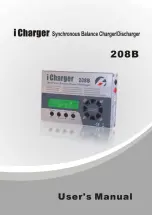
-6-
iCharger Synchronous Balance Charger/Discharger 208B
Warnings and Safety notes
Keep the charger away from children and pets at all times.
Never leave the charger unsupervised when charging or discharging. If you leave, disconnect the battery
to prevent any unexpected dangers or damage.
Ensure the charger program and settings match the battery pack otherwise the battery will be damaged
and a dangerous situation may arise, especially for Lithium batteries, which may cause a fire.
Do not mix batteries of different types, different capacities or from different manufacturers.
Do not disassemble the charger.
Do not place the charger or any battery on a flammable surface or near a combustible material while in
use. Do not charge or discharge on a carpet, cluttered workbench, paper, plastic, vinyl, leather or wood,
inside an R/C model or inside a full-sized automobile.
Never block the air intake holes and never use in a refrigerated or high temperature environment. If used
in such an environment, the internal temperature protection may result in abnormal charging/discharging
that could be dangerous.
Do not allow water, moisture, metal wires or other conductive material into the charger.
Never charge or discharge any battery having evidence of leaking, expansion/swelling, damaged outer
cover or case, color-change or distortion.
Do not try to charge ―non-rechargeable‖ dry cells.
Do not exceed the battery manufacturer‘s suggested maximum charge rates.
Beware that the external case temperature of the charger will increase during charging/discharging at
high power.
Carefully follow the battery pack manufacturer‘s recommendations and safety advice.
Recommended connecting way:
1. Connect
iCharger
's input power supply, and turn on it.
2. Connect Li batteries' balance port
3. Connect the main charging port's positive pole to cells' positive pole, and then connect negative pole to
cells' negative pole (this will avoid striking fire while connecting Li cells).
4. Start charging and discharging...
5. After finishing charging and discharging, pls disconnect the cell and charger, and then turn off the charger's
power supply.
Standard battery parameters
LiPo
LiIo
LiFe
NiCd
NiMH
Pb
Nominal voltage
3.7 V/cell
3.6 V/cell
3.3 V/cell
1.20 V/cell 1.20 V/cell
2.0 V/cell
Max. charge voltage
4.2 V/cell
4.1 V/cell
3.6 V/cell
1.60 V/cell 1.60 V/cell 2.45 V/cell
Storage voltage
3.85 V/cell
3.75 V/cell
3.3 V/cell
n/a
n/a
n/a
Allowable fast charge
current
≤ 1C
≤ 1C
≤ 4C
1C –
2C
1C –
2C
≤ 0.4C
Min. discharge voltage
cut-off level
cut off level
≥ 3.0 V/cell ≥ 2.5 V/cell ≥ 2.0 V/cell ≥ 0.85V/cell ≥ 1.0 V/cell ≥ 1.75V/cell
Note:
Be very careful to choose the correct voltage for different types of battery otherwise you may cause
damage to the batteries. Incorrect settings could cause the cells to vent, burn or explode leading to injury or
loss of property.
Summary of Contents for 208B
Page 1: ......







































